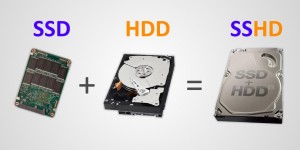 You’ve probably heard of SSDs (solid state drives). These are hard drives that use a type of very fast and very robust flash memory for data storage instead of a spinning magnetic disc.
You’ve probably heard of SSDs (solid state drives). These are hard drives that use a type of very fast and very robust flash memory for data storage instead of a spinning magnetic disc.
SSDs are very fast, and until recently, their storage capacity was limited relative to old-fashioned mechanical spinning HDDs. They were also rather pricey.
You probably haven’t heard quite as much about SSHDs: hybrid mechanical hard drives with a small amount of SSD-type storage built-in. The idea here is that the SSD part of the drive can be accessed very quickly, so it acts as a very fast buffer between your puter and the slower mechanical part of the drive.
The result? SSHDs are faster than a mechanical HDD, not as fast as an SSD, but still offer 2TB, 4TB, or even more storage space – all at an affordable price.
Shouldn’t I just get an SSD?
Well, yes, if you can. The prices of SSDs have dropped dramatically. You can now get a 250GB SSD for about $80, a 500GB SSD for almost double that, and only the 1TB drives are hovering in the several hundred dollar price range. A 1TB regular HDD is much cheaper than that!
And yes, it is true that SSDs are typically much faster. For example, the Samsung EVO 850 drives hover around 550MB/s read speed, and a bit slower for writes. Your typical mechanical hard drive is lucky if it can hit 100MB/s – and that’s only for specific read/write operations.
As a general rule, a modern SSD is about 10 times faster than an HDD – and it shows. Install an SSD in your puter, plop Windows on it, and boot ‘er up. If you don’t fall off your chair, I’ll give you a Ferrari… as soon as I win the lottery.
Then what’s the real benefit of the SSHD?
The main benefit of SSHDs is for situations like a laptop where you can only install 1 drive. If you can happily live with 250GB or 500GB of total storage space, by all means replace your mechanical lappy HDD with an SSD!
But if you need more storage space, a hybrid SSHD is perfect. Not as fast as an SSD, but you get more speed and the monster storage capacity you need – even in a laptop.
Generally speaking, a 2TB SSHD will be only about 20% higher in price than a regular 2TB HDD.

 What about dual drive setups?
What about dual drive setups?
Usually for a desktop puter, you’ll want to have an SSD that’s smaller and a traditional HDD that’s bigger (for data storage).
This means your OS and programs can run off the SSD, and you’ll have ultra-zippy boot times, very fast program load times, and generally lots of speed. For storing all your big files, you’ve got your trusty multi-TB HDD.
There is another option, however: SSD + SSHD
This setup will be exactly the same as above, except that your data storage drive is now a hybrid SSHD. Frankly, this particular setup is ideal at the moment. Due to the SSD integrated in an SSHD drive, data transfer rates for SSHDs are typically twice that of a mechanical-only HDD.
For example, the Seagate SSHD drives have a read/write speed on the order of 180MB/s – real speed, not “ideal conditions speed” or “benchmarked speed”! They are faster than even “high-end” mechanical HDDs like WD’s Black series of drives.
That means when you’re running Photoshop off your SSD, and you open that giant PSD file stored on your data drive, it will load and save twice as fast. Pretty handy!
You get maximum speed and maximum storage.
How do I transfer my data to a new SSD or SSHD?
This part can get a bit technical, but it’s not too hard.
Basically, you need to connect your new drive to your puter via a free SATA cable/port. If you have a laptop, you may need to use your desktop puter, or borrow somebody else’s desktop and connect your old drive and the new one to 2 different SATA ports on the motherboard.
Once that’s done, I highly recommend Paragon Hard Disk Manager 15 Suite. It’s not free, but it makes copying an entire drive – even a boot drive – VERY easy. It also has a built-in “Migrate OS to SSD” drive copying function that takes the headache out of upgrading your drive. It just works.
Once the copy is done, shut down, and replace your old drive with the new SSD or SSHD that is now a mirror image of your old drive.
Boot, and you’re done!







Recent Comments